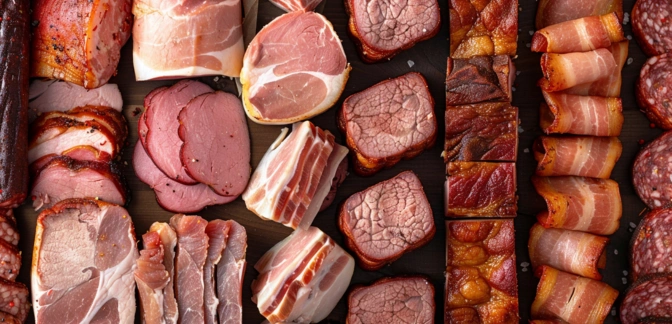Pork Chops — Nutrients, Health Benefits, And Shopping Tips

Written by Listonic Team
Last update on September 4, 2024
Pork chops nutrients
Nutrition facts
Amount per 100 g
Calories
🔥 231 kcal
| Nutrition per: 100 g | Value | % Daily Value* |
|---|---|---|
| Carbs | 0 g | - |
| Fiber | 0 g | - |
| Sugars | 0 g | - |
| Glycemic Index | 0 | - |
| Protein | 26 g | 52% |
| Sodium | 62 mg | 2.7% |
| Total Fat | 14 g | 17.95% |
*The % of Daily Value (DV) tells you how much a nutrient in a serving of food contributes to a daily diet. 2,000 calories a day is used for general nutrition advice.
26 g
💪 High Protein Content
Pork chops facts & tips
Health benefits
- High in protein, essential for muscle growth, repair, and overall body function.
- Rich in essential vitamins and minerals such as Vitamin B12, niacin, selenium, and zinc, which support overall health and well-being.
- Contains healthy fats (especially if trimmed of excess fat), which provide energy and support cell function.
- Versatile and easy to cook, making them a convenient addition to a variety of meals and recipes.
Health risks
- High fat content particularly in pork chops with visible fat or when cooked with added fats, which can raise cholesterol levels and increase the risk of heart disease when consumed frequently.
- High sodium content in seasoned or marinated pork chops, which can contribute to hypertension and increased cardiovascular risks.
- Potential for contamination with harmful bacteria such as Salmonella or Trichinella, particularly if pork chops are not properly cooked or stored, leading to potential foodborne illness.
- Potential for high calorie content which can contribute to weight gain if consumed frequently or in large portions, especially when paired with calorie-dense sides or sauces.
- Risk of carcinogen formation when pork chops are grilled or charred at high temperatures, which can produce harmful compounds like heterocyclic amines (HCAs) and polycyclic aromatic hydrocarbons (PAHs).
How to choose pork chops
Pork chops should have a pale pink hue and be firm to the touch, with a small amount of marbling, which can indicate good quality and flavor. The meat should have no off odors, and the packaging should be vacuum-sealed to preserve freshness.
Avoid pork chops that are discolored or have a sour smell, signs that the meat is no longer fresh. Packaging that is loose or has holes should also be avoided, as this can lead to air exposure and spoilage.

How to store pork chops
Pork chops should be stored in the refrigerator, tightly wrapped in plastic wrap or butcher paper. Refrigeration keeps them fresh for up to three days. For longer storage, freezing is recommended.
Air exposure can cause pork chops to spoil quickly. Avoid leaving them uncovered, and always thaw frozen pork chops in the refrigerator. Proper handling and storage prevent bacterial growth and maintain quality.
✅ Extra Tip
How long do they last?
Popsicles can last for 6-8 months when stored in the freezer. Proper storage helps maintain their flavor and texture, making them a refreshing treat anytime. Ensure they are stored in an airtight container to prevent freezer burn.
What to do with leftovers?
Leftover pork chops can be used in a variety of savory and hearty dishes. Slice them thinly and add to sandwiches, wraps, or salads for a quick and easy meal, or chop them up and mix into a stir-fry with vegetables and your favorite sauce. Pork chops are also great when used as a filling for tacos, burritos, or quesadillas.
Use pork chops in a casserole with potatoes, vegetables, and cheese, or mix them into a pasta dish with a creamy or tomato-based sauce. If you have a lot of pork chops, consider making a batch of pork fried rice by chopping the meat and mixing it with cooked rice, eggs, and vegetables. Pork chops can also be sliced and added to a pizza or flatbread, or used as a topping for grain bowls with quinoa, farro, or couscous. For a quick snack, enjoy pork chops with a dipping sauce like barbecue, honey mustard, or salsa, or mix them into a salad with fresh vegetables and a tangy vinaigrette.
👨⚕️️ Medical disclaimer
Discover products from other categories
Listonic Team
Fact-checked
Our editorial team checked this article to make sure it was accurate at the time of publishing it.
Get the top-rated shopping list app

pork chops
1 piece
Outline







